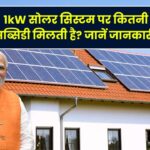
In today’s world, energy costs are rising, and communities across the globe are looking for innovative ways to reduce their electricity bills. One town, in particular, has made waves by cutting its power bills by an impressive 70% through the adoption of a simple yet brilliant solar energy solution. This transformation not only benefited the residents financially but also helped the environment. But how did they manage such a significant reduction in power bills? What solar energy trick did they use? Let’s explore the story behind this achievement and understand how you can replicate it in your community.
Also Check: Enphase Energy: Analysts Say ‘Hold’ – Should You Listen or Take Action?
How Solar Power Became a Game-Changer
In the town that implemented this solar-powered transformation, the idea to install solar panels came about as a means of cutting costs and improving sustainability. The community, like many others, had been facing steadily increasing electricity rates, making monthly power bills a significant burden. With this in mind, leaders from the town’s local government and sustainability teams decided to investigate solar energy as a solution.
The breakthrough came when the community decided to adopt a rooftop solar system that could power common areas and local infrastructure. Solar power has gained popularity worldwide due to its cost-effectiveness and environmental benefits. By investing in solar panels, the town was able to generate its own electricity, significantly reducing its reliance on the national grid.
The Genius Solar Trick That Cut Power Bills by 70%
The “genius trick” behind the power bill reduction was not some new, experimental technology, but rather a smart, simple approach to using existing solar technology in an efficient manner. Here’s how they did it:
Step 1: Solar Panel Installation
The first step was to install high-quality solar panels on the rooftops of public buildings, residential complexes, and schools in the area. These solar panels capture the energy from the sun and convert it into electricity. Depending on the location and the amount of sunlight, these panels can produce significant amounts of energy during daylight hours.
Step 2: Energy Storage Systems
To maximize the benefits of solar energy, the community integrated solar batteries. These batteries store excess electricity produced during the day so that it can be used during the night or on cloudy days when solar production is lower. The energy storage system ensures a consistent energy supply, even when the sun isn’t shining.
Step 3: Energy Monitoring and Optimization
The final key element was energy optimization. Using advanced software and monitoring tools, the town could track and manage the amount of energy generated, consumed, and stored. By analyzing consumption patterns, they were able to optimize when energy should be used, reducing waste and maximizing efficiency.
Step 4: Community-Wide Implementation
Instead of limiting the installation to just a few buildings, the town took a holistic approach. They involved the entire community in the project, encouraging everyone to adopt solar panels for their homes, businesses, and public spaces. With more solar panels installed, the town could collectively harness a larger portion of the energy from the sun, resulting in even greater savings on electricity costs.
Why Solar Power is a Smart Investment
For communities considering solar power as an option to cut electricity bills, here’s why this renewable energy source is an excellent investment:
Cost Savings
Solar energy can drastically reduce or eliminate monthly power bills. In many cases, solar systems can pay for themselves within a few years. The initial installation cost is usually the most significant barrier, but after the panels are installed, maintenance costs are low, and the energy they generate is free.
Energy Independence
One of the main advantages of solar power is that it reduces reliance on the grid. This means that your community is less vulnerable to rising electricity rates and power outages. Solar systems can generate electricity locally, keeping costs stable and providing energy security.
Environmental Benefits
By investing in solar energy, communities also contribute to a cleaner, healthier environment. Solar power is renewable and produces no harmful emissions, unlike traditional energy sources like coal or natural gas. This helps reduce the carbon footprint and combat climate change.
Government Incentives
Many governments offer incentives and tax breaks for communities and businesses that invest in solar energy. These incentives help offset the initial installation costs, making solar energy more affordable and attractive.
Also Check: Flexible Solar Cells Smash Efficiency Records – A New Era for Clean Energy!
How You Can Implement Solar Energy in Your Community
If you’re inspired by the success of this town and want to bring similar benefits to your community, here’s a simple step-by-step guide on how you can get started with solar energy:
Step 1: Conduct a Feasibility Study
Before diving into a solar project, it’s crucial to assess whether solar energy is right for your community. You can start by conducting a feasibility study to evaluate the amount of sunlight your area receives, the type of buildings you have, and your community’s overall energy needs.
Step 2: Choose the Right Solar System
There are various types of solar systems to choose from, including grid-tied, off-grid, and hybrid systems. Depending on your goals and location, you may choose a system that allows you to remain connected to the national grid or one that operates completely off the grid.
Step 3: Find a Reliable Solar Installer
Look for an experienced solar energy installer to guide you through the process. They will help you choose the best equipment and handle the installation. Be sure to ask for references and check reviews before making a decision.
Step 4: Apply for Incentives and Grants
Research any available government incentives or grants to help offset the cost of installation. Many local and national programs provide funding for renewable energy projects, making it easier for communities to adopt solar energy.
Step 5: Monitor and Optimize Energy Use
Once the solar system is installed, continue to monitor its performance to ensure it’s running at full capacity. Using energy optimization tools, you can make adjustments as needed to further reduce costs and improve efficiency.
(FAQs)
1. How long does it take for solar panels to pay for themselves?
The time it takes for solar panels to pay for themselves can vary based on the size of the system, local electricity prices, and the amount of sunlight in your area. Typically, it takes 5 to 10 years for the system to break even, after which the energy savings continue.
2. Are solar panels reliable in cloudy areas?
Yes, solar panels can still generate electricity on cloudy days, though they are most efficient in direct sunlight. Even in cloudy areas, solar energy can be a reliable source of power, especially when paired with energy storage systems.
3. Can I install solar panels on my home?
Absolutely! Homeowners can install solar panels on their roofs or property. Many homeowners have benefited from installing solar panels, enjoying reduced electricity bills and increased property value.
4. Do I need to connect my solar system to the grid?
Not necessarily. There are both grid-tied and off-grid systems. If you want to store excess energy or live in a remote area, an off-grid system might be the best choice. However, being connected to the grid allows you to sell back excess energy.
Also Check: SolarEdge Stock Gaps Up Big! Is Now the Perfect Time to Buy?









